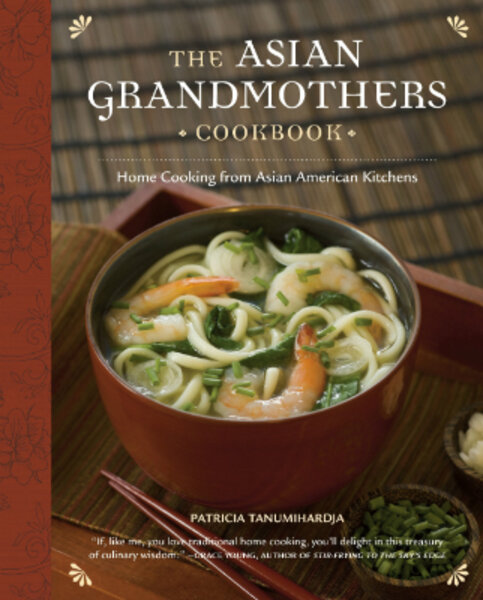Cookbook review: The Asian Grandmothers Cookbook
Loading...
There's a reason I go out to eat Asian food: I don't have a wok, the ingredients, or the time.
Not only does Asian cuisine require those three things, but you also need someone watching over your shoulder who knows what to do. That's where The Asian Grandmothers Cookbook by Patricia Tanumihardja comes in handy (available in paperback from Sasquatch Books on Aug. 21). In her book, Tanumihardja offers a straightforward approach to cooking elaborate recipes and outlines the ingredients, process, and preparation needed for each.
Tanumihardja didn't just want to write any ordinary how-to cookbook. She wanted to go straight to the source of Asian cuisine: the grandmother. She claims, “All grandmothers are the keepers of culture and the culinary flame,” and thus proceeds to seek out grandmothers, mothers, and other "goddesses of the kitchen" to record their unique recipes, often only passed down orally. Each recipe has detailed instructions so that even the novice can take a crack at it. The cookbook also includes profiles of the women behind the recipes, some of whom have fascinating stories to tell.
“The Asian Grandmothers Cookbook” includes a myriad of dishes ranging from Chinese, Japanese, Korean, Indian, Vietnamese, Filipino, and everything in between. Additionally, the dishes allow for a lot of experimentation – if you don't like a certain ingredient or if a certain sauce is too hard to find, you can easily replace it with other seasonings. If you're worried about hard-to-find ingredients, fret not. You can find most of the items at your local Chinatown or Korea Mart, and even grocery stores like Whole Foods have many of the foreign ingredients you will need.
The best feature of the cookbook is an entire glossary of the Asian cabinet with descriptions of each type of item you might find in it, including all variations of noodles, rice, and sauces. It also explains the different processes of Asian cooking, such as steaming, deep-frying, and stir-frying and the different kitchen implements needed and substitutes you can use. The outlining is essential if you've never thought of cooking Asian food on your own, and proved extremely helpful when I tried two of the book's recipes.
Here's the account of my attempt to make japchae (or chapchae), a mixture of glass noodles and vegetables including carrots, onions, and mushrooms, usually served as a side dish in Korea. Some background is needed:
I've never cooked anything very Asian apart from a simple stir-fry, and never thought I'd have a reason to with dozens of options outside my door. But when my family's favorite Korean restaurant went out of business, there was nowhere else to find the same authentic Korean cuisine. Sure, there were plenty of Japanese-Korean-Chinese fusions that offered similar dishes, but they just weren’t the same.
Japchae was one dish that I would always order and which I could not find at any other Asian restaurant. I am absolutely in love with this dish, and missed it so badly that when I traveled to South Korea with three of my friends I was eager to taste it again.
During my time in Korea, we visited the island of Jeju off the southern coast of South Korea. The island is known for its touring honeymoon couples who wear matching shirts as they explore its famous dormant volcano and other natural wonders. My Korean friend's grandparents kindly hosted us while we were there, and every morning we would awake to a full Korean breakfast, featuring mouth-firing kimchi, purple sticky rice, pork with onions, and several other dishes. I couldn't speak to YoungSun Kim, my friend's grandmother, who spent hours preparing each meal, but I was able to utter an abundance of badly pronounced kamsahamnidas (thank yous).
I gratefully received her many homemade traditional dishes that are difficult to find in the United States. That's why I was delighted to see so many unique recipes in "The Asian Grandmothers Cookbook." As you might guess, I was most excited about the recipe for japchae.
Because japchae is a side dish, I chose to make Thai basil pork as a main course. There is a Korean mart called Lotte Market on my way home from work and I went there to pick up the necessary ingredients. I told the storekeepers what I was making, and they helped me navigate the dozens of sauces, noodles, and vegetables to find the right ones.
Once home, I immediately placed the dried mushrooms in a bowl of water to soak. I should have begun chopping all the rest of the ingredients, but instead followed the directions and soaked the noodles and spinach. This was a mistake. Although it might seem obvious to chop everything ahead of time so that it's ready to go in, I didn't do this step until after everything else was ready to go, which made the whole process take much longer.
Ideally, after taking care of the mushrooms, chop as much as the ingredients as possible. Towards the end of chopping, soak the noodles, and at the very end, soak the spinach. After that, follow the directions provided and you should be golden!
After the many hours spent preparing the japchae, I was happy to find that it tasted just like japchae should: noodle-y with a sweet flavoring soaked in. The noodles were a bit larger than normal japchae noodles tend to be, the carrots were chunks rather than thin julienne slices, and I would have liked more onion and spinach interspersed throughout, but apart from these details, which can be easily fixed, the dish was a success.
Japchae
Serves 6-8
1 pound dried Korean sweet potato noodles
Hot water
8 ounces spinach, trimmed (4 to 5 cups)
2 tablespoons vegetable oil, plus more as needed
6 medium dried black mushrooms, rehydrated and cut into thin slices (3/4 cup)
To rehydrate: soak in water for 30 minutes or several hours if you start ahead of time
1 small yellow onion, halved and cut into thin crescents
2 medium carrots, peeled and cut into thin crescents
3 green onions, white and green parts, cut into 1-inch lengths
2 cloves garlic, minced
1/3 cup soy sauce
3 tablespoons brown sugar
1 tablespoon sesame oil
1 tablespoon toasted sesame seeds
Place the noodles in a heatproof bow and soak in hot water for 15 minutes. With kitchen shears, cut into 3- to 4-inch pieces. You just want the noodles to be manageable so don’t worry about getting exact lengths. Drain and set aside.
Place the spinach in a heatproof bowl and soak in very hot water for 1 to 2 minutes until wilted but not fully cooked. Rinse under cold running water and drain. Gently squeeze the water from the spinach and cut into 3 sections.
Preheat a large wok or skillet over medium-high heat for 1 minute swirl in the oil and heat until it becomes runny and starts to shimmer. Add the mushrooms, onions, carrots, green onions, and garlic and stir and cook until the carrots are crisp tender, 2 to 3 minutes. Reduce the heat to medium and toss in the noodles. Add the soy sauce, brown sugar, and sesame oil. Stir everything swiftly around the wok for 3 to 4 minutes, coating the noodles evenly with the seasonings. Add more oil if the noodles stick to the bottom of the wok. Taste and adjust seasonings if desired. Mix in the spinach and sesame seeds at the very end and toss with a couple more flourishes. Serve hot or let cool to room temperature.








